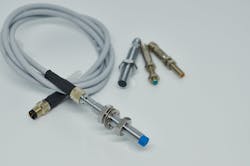Walk into any factory, and, if you look closely, you will see an incredible number of proximity switches on nearly every piece of equipment on every line. Proximity switches, or just “prox switches” for short, are a huge multi-billion dollar industry, and that’s not even including the associated cables and cord sets that connect them to the automation controller inputs.
Generically, prox switches are used for a multitude of tasks in a manufacturing line, both for the operation of the machinery itself and to detect the presence of ware. On the machinery side, for instance, proxes are used for sensing when hydraulic or pneumatic slides are at one end or another of their range of travel, or to act as home switches for servo-drive axes.
The same detection ability is also useful when needing to detect the presence of ware, raw materials, components or fluid levels in a process. Accordingly, when used in this manner, we typically refer to these prox switches as “presence sensors”— same devices, just used in a slightly different way.
Types of proximity switches
Although presence sensing can be done by other types of sensors, such as ultrasonic and photo-optic, or even with vision systems, proximity switches are a great low-cost, low-complexity and high-reliability non-contact method of accomplishing this task. Within the category, there are three different types of proximity switches for sensing different materials in different ways.
The most common type of prox/presence sensor seen in industry are inductive proximity switches. Their big limitation is that they are applicable to only sensing metallic objects. Developed in the 1950s, these sensors generate an alternating magnetic field through a coil in the tip of the barrel of the switch, and changes to the field caused by a metallic object in the field are detected by a trigger circuit in the switch. The sensing range is typically determined by the physical size of the proximity switch and the shape of the magnetic field. These units are robust, vibration- and shock-resistant, and usually sealed and potted to be washdown-capable. They can be subject to false triggers in the presence of electrical noise, poor grounding practices or the presence of metallic filings or dusts, so care must be taken to ensure their implementation works in the environment needed.
Although they may look similar to their inductive counterparts, capacitive prox switches work on a different detection method. As the name implies, these work on capacitance rather than inductance. This means they are not limited to metallic objects, but can detect anything that changes the capacitance of the sensor circuit. They detect the changes in capacitance between the sensor and the object being detected with reference to a virtual ground. The closer the material is to the sensing end, the greater the capacitance, and, once it reaches a trigger point, the internal circuitry enables the outputs. Materials that can be sensed include metals, fluids and non-metallic solids and semi-solids. The sensing range of a capacitive proximity switch is affected by the dielectric constant of the material being sensed, so most include some mechanism for calibrating the sensing distance, such as a set screw in the body of the switch. As with inductive switches, capacitive prox switches are also susceptible to electrical noise, poor grounding practices and some particulates in the air, but mostly immune from vibration and shock. The typical capacitive prox switch housing is also washdown-compatible.
Probably the simplest of the three types of presence sensors, magnetic prox switches are limited to detecting magnetic materials only, such as a permanent magnet. The most common type of magnetic prox switch is a “magnetic reed switch,” which has two thin metallic plates, or reeds, enclosed in a glass bulb with inert gas inside. The reeds are connected to the output stage of the switch. In the presence of a magnet, the reeds flex and contact each other, completing the circuit and closing the contacts. Because these are more or less mechanical devices, they are almost completely immune from issues arising from electrical noise, but they can be susceptible to issues with vibration and shock, which can cause the reeds to make contact intermittently, giving momentary false-positive indications.
Using proximity switches in an industrial application can be a cost-effective method to detect the presence of ware or materials. Regardless of which proximity switch you use as a presence sensor, make sure it fits the application by ensuring the switch is correct for the environment, the material being sensed and the range of sensing required.
About the Author

Joey Stubbs
contributing editor
Joey Stubbs is a former Navy nuclear technician, holds a BSEE from the University of South Carolina, was a development engineer in the fiber optics industry and is the former head of the EtherCAT Technology group in North America.

Leaders relevant to this article:
